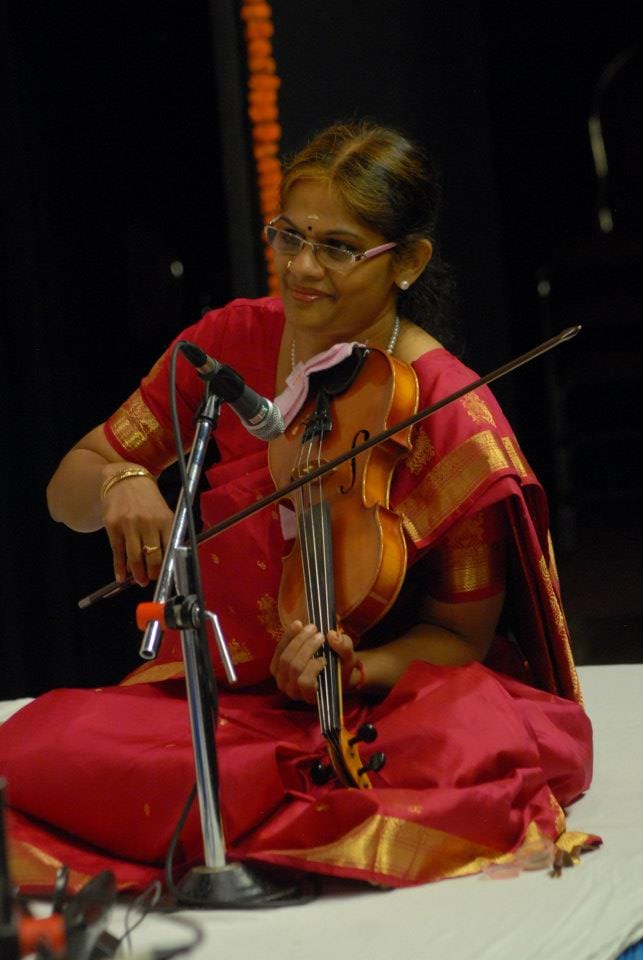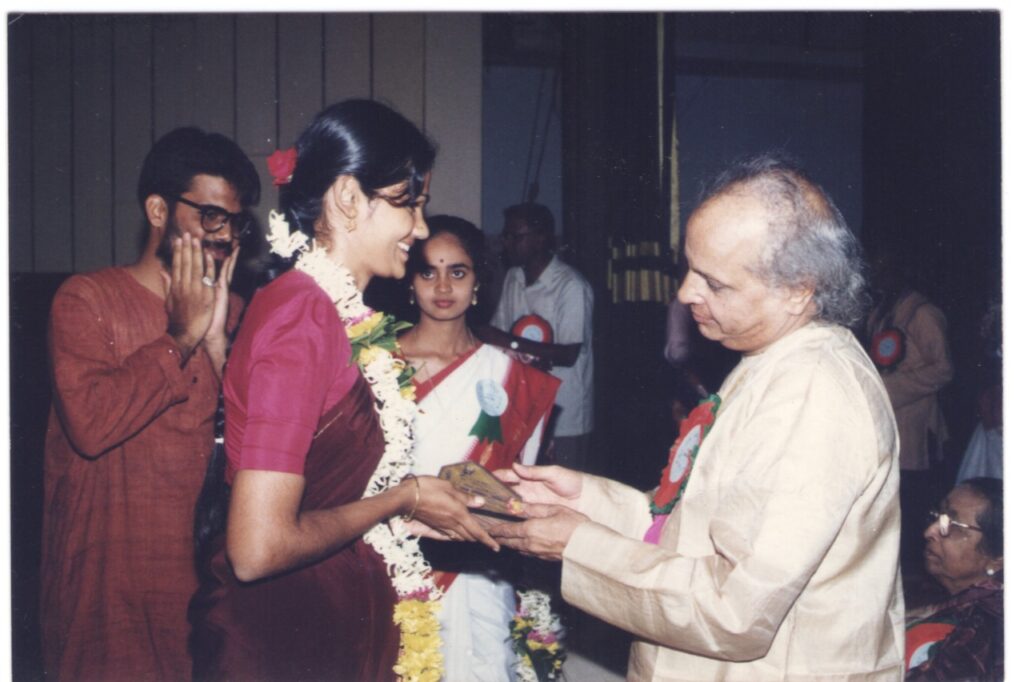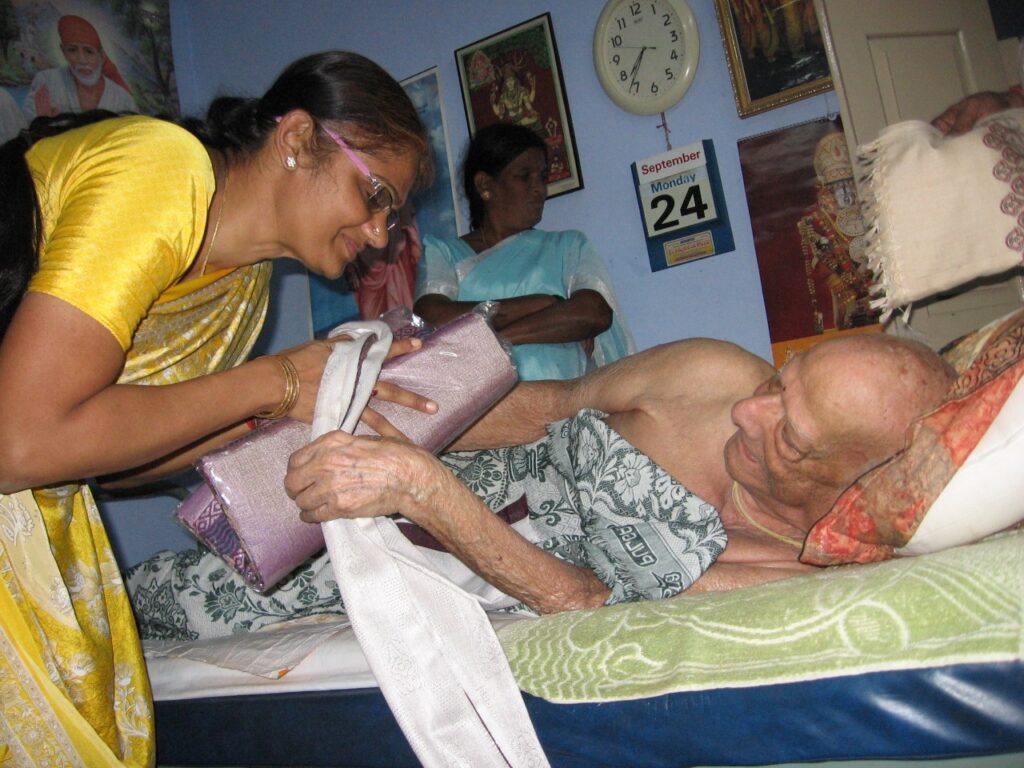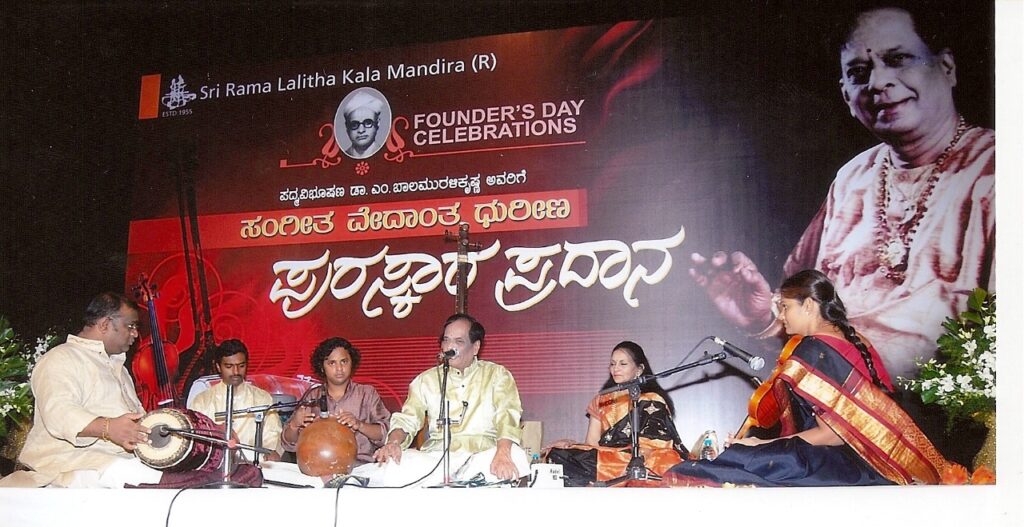Charulatha Ramanujam

If one has to be recognised in Carnatic music, one just HAS to relocate to Chennai, it is said. There can be no substitute for listening to live concerts is also oft-heard. This respected violinist, however, has put paid to both the above statements. Charulatha Ramanujam is appreciated not only for irreproachable skill but also her impeccable attitude on and off stage.
Sangita Kalanidhi Dr. S. Sowmya, known for her candour, says with feeling, “In all aspects, right from never speaking with a raised voice to always being cheerful, Charulatha is exemplary. Her musicianship – the artistry she brings forth – is the jewel in the crown. She is just amazing in being both a student and a great artiste. For me personally, had she said she could not play, I would have had to entirely forget about presenting Ganta on stage at The Music Academy. We explored it together.”
Vocalist N. Vijay Siva says, “There is a distinct sweetness in Charulatha Ramanujam’s bowing which can easily settle the main artiste with his/her music. She helps them deliver with natural ease. And it is not just her musical prowess that facilitates this; it is her complete involvement with the music on stage. She lends dignity to the concert ambience. Her camaraderie boosts your confidence. She always sends a positive signal to the fellow vidvAn– ‘I am with you.'”
The artistes Charulatha Ramanujam has played for reads like a veritable Rolodex of the Carnatic fraternity, and this is by no means an exhaustive list!
Sangita Kalanidhi-s Dr. Sripada Pinakapani, Dr. M. Balamuralikrishna, B. Rajam Iyer, Mani Krishnaswamy, R.K. Srikantan, T.K. Govinda Rao, R. Vedavalli, Bombay Sisters, Sudha Ragunathan, T.V. Gopalakrishnan, N. Ravikiran, Aruna Sairam and Dr. S. Sowmya;
A version of this article appeared in The Hindu. Many thanks to Sri. E.S. Ramanujam for painstakingly going through extensive archives to pull out many photographs, audio and video clips, for this article.
Nookala China Satyanarayana, Suguna Purushothaman, Parassala Ponnammal, Palai Ramachandran, Hyderabad Brothers, Madurai G.S. Mani, Malladi Suri Babu, Rudrapatnam Brothers, Neela Ramgopal, Seetha Narayanan, Rama Ravi, Seetha Rajan, Bangalore S. Shankar, Suguna Varadachari, Manda Sudha Rani, Charumathi Ramachandran, M.S. Sheela, Dr. T.S. Sathyavathi, Neyveli Santhanagopalan, Malladi Brothers, Dr. Sundar, Madurai R Sundar, Vasundhara Rajagopal, Dr. Nagamani Srinath, Rajkumar Bharathi, N. Vijay Siva, Dr. Pantula Rama, P. Unnikrishnan, Gayathri Girish, Dr. G. Baby Sreeram, Shertalai Renganatha Sharma, Sankari Krishnan, Sreevalson Menon, Savita Narasimhan, Sriram Parthasarathy, Ranjani and Gayatri, T.M. Krishna, Vishakha Hari, Gayathri Venkataraghavan, Akkarai Sisters, Abhishek Raghuram, Sikkil Gurucharan, Pattabhirama Pandit, Amritha Murali, Ramakrishnan Murthy, Bharat Sundar, G. Ravi Kiran, Vignesh Ishwar, K. Gayatri, Nisha Rajagopal, Saketharaman, Amrutha Venkatesh, Aishwarya Vidhya Raghunath, Sriranjani Santhanagopalan and more.
Charulatha grew up in Tirupati in a large joint family. She recollects music being ever present in her home. However, but for her paternal aunt, nobody had learned formally. “It was all kelvi gnanam (knowledge acquired by listening).” Her grandmother, Kandadai Krishnaveni Amma, had composed many pieces on Lord Srinivasa Perumal, set to major rAgam-s like sankarAbharaNam, tODi, kAmbhOji etc. A routine pastime in their home was her grandmother singing and Charulatha’s aunt accompanying her on the violin – surrounding relatives would request pieces that they would sing and play. Charulatha’s father, K. Rangaswamy, was a good self-taught singer reminiscent of Dr. S. Ramanathan – when Sandhyavandanam Srinivasa Rao heard Rangaswamy, a young boy then, he was struck by his prodigious talent. “Appa’s knowledge was entirely through listening to live concerts. He had observed and absorbed a lot of knowledge on not just the music but also kutcheri paddhati,” says Charulatha.

Charulatha began learning violin at age 7 in Tirupati from Pudukottai Ramanathan, a student of Kumbakonam Rajamanickam Pillai, and was under his tutelage for 12 years. “He started teaching me from the basics and took me to ragam, neraval and swaram.” He also taught her to notate songs though she adds that he would say that one should not play based on notation alone – it was but a guide and styles varied. Charulatha would wake up at 3 am daily and practice for 3-4 hours. Every family member would vigilantly listen ensuring that errors were promptly corrected. She did a BA in English Literature, was married soon after and moved to Bangalore. There, she took lessons from her husband’s teacher, Anoor S. Ramakrishna, father of mridangist Anoor Ananthakrishna Sharma.
Unlike most artistes who have listened to many live concerts, Charulatha had hardly attended any until she began playing for concerts herself. In Bangalore, she got access to a large collection of yesteryear recordings. “I had never even heard of most of those artistes!” She began playing alongside those recordings for practice, the home becoming her concert hall. She learned a lot here both in terms of musicality and accompaniment. Here, she says that she has always enjoy playing for vocal vs solo (though she has given solo performances too) – “When someone sings well, I enjoy soaking in that music and trying to be in that moment for just a little while longer.”
Barely a year after marriage, the couple moved to Hubli where they lived for a decade. Charulatha began playing at the local sabha, Ganasudha, for artistes visiting from Chennai, Bangalore, Hyderabad and Kerala, including Rajkumar Bharathi, TR Subramaniam, Rudrapatnam Brothers, Hyderabad Sisters and more. Many of these artistes then started calling her for concerts in Chennai and other cities too. Besides, Hubli being more attuned towards Hindustani music, she started showing interest in learning rudiments of that genre too which she did from Shripati Padigar, a direct disciple of Pandit Bhimsen Joshi. She provides saath for some local artistes. “It made me more aware of Sruti Suddham and sowkhyam.”
Following Ramanathan’s suggestion, she learned new songs from recordings of DK Pattammal and DK Jayaraman, who are known for never varying the singing of kriti-s. She began notating renditions of songs by artistes she played for, further increasing her awareness of different styles.
After Anoor Ramakrishna’s passing, Charulatha joined Sangita Kalanidhi R.K. Srikantan. “He would sing and I would play it on the violin. His was impeccable pATAntaram. He believed in very careful notation – every anuswaram would be written carefully and he would insist that I follow that faithfully. He would also ask me to notate some songs.”
Ramanathan, having accompanied for many himself, had interspersed tips for accompaniment in the course of her early classes. She remembered those – playing a sangati perfectly the second time it was sung, for example, keeping her ear attuned to exactly how the artiste rendered it the first time. Her father added on many valuable suggestions. He told her the importance of understanding the meaning of the pieces she played for, and playing true to the ‘sahitya’. She took this very seriously. Charulatha ponders over the meaning of every kriti – she will take pains to find the meaning of words she does not understand. “I think the words show us a path to follow. It helps us with our own upliftment. To me it is a prayer.” Sangita Kala Acharya Neela Ramgopal who guides Charulatha currently, says, “Charulatha’s knowledge of Telugu, Sanskrit and Kannada means she plays faithfully to the lyrics of anything she plays. I consult her for questions on the Telugu script.”

Charulatha has given vocal performances too. She says it was just an organic extension of knowing the lyrics and the tunes but she has not been formally trained on vocal. It seems to have been a symbiotic relationship. Vocalist Bangalore S. Shankar, for whom she has played for over twenty years, says, “Being a very good vocalist herself, she knows the requirements of a vocalist. She does not overdo or overshadow the main artiste. She will ask about any rare ragams or pieces that might be sung. She also never demands to raise the volume of the microphone – a very rare thing these days. She also has extremely pleasing manners.”
There are certain good accompanying practices she observes. This includes not rushing to follow an artiste at the start of an AlApana. “Many rAgam-s can start similarly. It is better to wait a tad, perhaps on the shadjam, to allow the artiste to collect his/her thoughts and then play” She prefers to be an ‘echo’, catching and playing the last few notes of AlApana phrases, non-intrusively. Neela Ramgopal says, “Many violinists complete the vocalist’s phrases for them. Charulatha will not do that – she is a very accomplished accompanist and is unobtrusive.” sowkhyam, or the overall feel, is of tremendous importance to Charulatha. As a result, she is not personally a fan of much calculation or kaNakku, though she can quickly execute kaNakku-s sung or played by other artistes.
Anoor Ramakrishna had introduced her to rAgam tAnam pallavi-s. She had also attended TR Subramaniam’s Pallavi workshops where he demystified pallavi-s – “’Pallavi-s with a smile’, he would call it,” says Charulatha smilingly. She played for the late Suguna Purushothaman on many occasions beginning with a program in 2000 in Hyderabad where Charulatha lived for five years. She played for avadhAna pallavi-s, one in lakshmISa tALam (24 or 25 aksharam-s based on source consulted) and more. In 2007, Suguna asked Charulatha to accompany her at The Music Academy where she sang a pallavi she executed in the since-famed 128 aksharam simhAnandana tALam. On that performance, Vijay Siva says, “Can anyone forget the way she reproduced the simhAnandana tALam pallavi in front of a packed audience while accompanying the pallavi wizard Suguna Purushothaman? And she did it as if it was yet another common pallavi– with absolutely no manifest or hidden tension. Obviously, her focus was hundred percent on the job and she was enjoying it too.”
Asked about her preparation for this challenging pallavi, Charulatha says, “I was not sure at all but Suguna mami had complete confidence that I could do it. She gave me a CD to listen to. There was nobody to put tALam for me during practice, but by paying attention to the words and their melody, the spacing and the number of aksharam-s per word, I could play it. I received positive feedback from mami and the many other doyens who attended that program.” She has played for several other challenging pallavi-s subsequently for other artistes as well.

As Charulatha played more concerts, in the absence of a regular guide for violin, she also worked on adapting fingering and playing techniques to best reflect the styles of the various artistes she played for. “I experimented with each finger to see what produced the best possible effect.”
Dr. Sowmya says, “If I have any gripes at all about Charulatha, it is that she is so busy that she is hardly available; secondly, she can get so lost in the music that she closes her eyes when she plays – in a concert, it is nice to interact with your co-artistes. But these are mere trifles. She is such a darling.”
Charulatha teaches vocal and violin but looks at herself as a perennial student. “I solicit feedback from the artistes I play for – it really helps me to know what I can do better. I can also count on my husband, as an educated listener, to give me candid feedback . I take these to heart and work to keep improving.”
Her accompaniment on the violin for an artist is enjoyable and comfortable not only for the artist but at the same time listener is exposed to an excellent and unobtrusive instrumental music to accompany the main artist. May God bless her with greater and greater achievement
Very pleasant artist with utmost humility. Her playing on the violin is as soft as her speech. Her accompaniment will never over shadow the main artist. In Kannada they say ” ಎಲೆ ಮರೆ ಕಾಯಿ”, which means “A fruit behind the leaves”. I wish Ma’am CR all the very best.
Anandam tharum inbamaana rendition. One can keep listening Charulatha and that gives all benefits of meditation. God bless her
Heart soothing music and gives all benefits of meditation
She is an amazing violinist
Looking forward for her vocal concert
Artist par excellence
Beautifully surmised by Dr. Saumya!! No words can be sufficient to express the joy of a listener or a person interacting with her. Best wishes to her to reach newer heights!!!
Thank you for reading and writing in.